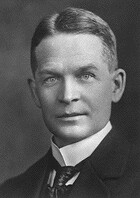Frederick Soddy (September 2, 1877 – September 22, 1956
 |
| Frederick Soddy |
Frederick Soddy was born September 2nd, 1877 in Eastbourne, Sussex, Englad to Benjamin Soddy. He was educated at Eastbourne Collage and later at the University College of Whales, Aberystwyth.
In 1895 he was granted a scholarship at Merton College, Oxford and graduated in 1898 with honors in chemistry. After two years research at Oxford he traveled to Canada and from 1900 till 1902 he was an instructor in the Chemistry Department of McGill University, Montreal.
| The bottom right coroner shows separate impact marks for the two isotopes of neon |
Soddy had discovered isotopes. Trying to explain why, based on his studies, there were 40 different radio-elements between Uranium and Lead, but the periodic table only allowed for 11. Soddy suggested that several types of atoms could occupy the same place in the table allowing for different radioactive properties. The term "isotope" is Greek for "at the same place" and was suggested to Soddy by Margret Todd a Scottish Physician and friend.
For his work on isotopes he received the Nobel Prize for chemistry .
He was also honored with the naming of a small crater after him that is located on the dark side of the moon.
~Yati














0 comments:
Post a Comment